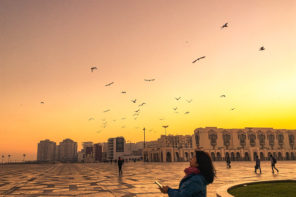You just have to walk down the street in any immigrant neighborhood—Washington Heights in New York City, Kreuzberg in Berlin, or the Bijlmer in Amsterdam—to realize that big changes are underway. No doubt many of the businesses you pass will have to do with migrants’ homelands, be they travel agencies; ethnic grocery stores selling fruits, and vegetables, phone cards, and videos; or stores that wire money to relatives back home. This is because more and more people continue to vote, pray, and invest in businesses in the places they come from at the same time that they buy homes, open stores, and join the PTA (Parent-Teacher Association) in the countries where they settle. Putting down roots where you move, while continuing to remain active in the economics and politics of your homeland, isn’t just for poor or working class migrants. Think of the many highly-educated, highly-skilled professionals who populate the board rooms and bedrooms of the world’s cities and suburbs. More and more, they too buy homes, raise children, invest, and cast ballots across borders.
As a matter of fact, more people than ever are on the move. In 2013, 232 million people, or 3.2 per cent of the world’s population, were international migrants, compared with 175 million in 2000 and 154 million in 1990. These individuals send a lot of money back home. According to World Bank, migrants from developing countries were expected to remit nearly $416 billion dollars in 2014. In countries like Mexico or Morocco, these contributions are one of the principal sources of foreign currency, and governments—now dependent on them—want to make sure the money keeps flowing. Migrants are also a tremendous source of ideas, know-how and skills, and some governments try to systematically harvest these social remittances as well.

Photo by LoggaWiggler – CC0 1.0
At the same time, we live in a world of heightened diversity. Because people from a wider range of countries—with different legal statuses and levels of access to benefits—travel to a greater variety of places, new patterns of inequality and discrimination are emerging. This new complexity layers onto existing patterns of socioeconomic diversity, residential segregation and social exclusion. In 2005, for example, people from more than 179 countries lived in London. How they answer the question “who are you?” gets complicated. They might respond that they are Dominican and American or Indian and British at the same time that they are New Yorkers or Londoners. They may also say that they are Muslim, a professor, or an environmentalist, thereby claiming place through their membership in a religious, professional, or activist tribe.
For some, living across borders comes easily. They have the education, skills, and social contacts to take advantage of opportunities anywhere. Many others are forced into transnational lives because they cannot provide adequately for their families in the places where they come from or where they move. Either way, today’s migrants are moving in a world of economic crisis, neoliberal restructuring, precarious jobs, and major cutbacks in social welfare. And while more and more people live transnational lives, they are still served by legal and social service systems that are stubbornly nationally bounded. The social contract between state and citizen is national, but people’s lives are not.
These dynamics challenge basic assumptions about how and where inequality is produced, family life gets lived, and the rights and responsibilities of citizenship get fulfilled. They raise questions about the new kinds of social safety nets and institutions that are needed to respond to people’s mobile lives.
But first, we need a different vocabulary that allows us to talk about nations that do not necessarily stop at their geographic borders. We need new ways of understanding identities that take into account that many people belong to several groups at once and that their multiple allegiances can co-exist if not complement each other. We need new strategies that help instill the willingness and skills to engage with difference across the world and across the street.

Photo by David Holt – CC BY-SA 2.0
Where do we learn to care about those who are different or to feel a sense of responsibility for groups other than our own? How do we learn to live in increasingly diverse neighborhoods and to connect that experience to people who live on the other side of the world? How might we begin to imagine a nation that does not necessarily stop at its borders and to create institutions of social protection and provision that better serve mobile lives?
Ever since August 1793, when France’s new leaders opened the doors of the Louvre to the public, museums have played a starring role in producing and representing nations. They helped create unified “teams” out of millions of people who would never meet by showcasing the knowledge and customs they share.
Even now, in museums on every continent, guests feast on paintings, furniture, and other decorative objects that they are told represent the nation. So, in today’s global world, what kinds of citizens are museums creating? Can they inspire an openness to difference, whether it be next door or across the world? How does the globalization of the museum world affect local institutions and how do local institutions talk back?
To answer these questions, I visited museums in Europe, the United States, Asia, and the Middle East. I talked with museum directors, curators, and policymakers about current and future exhibitions and collected their stories about the paintings, iconic objects, and sometimes quirky benefactors that define their collections. In the United States, I compare museums in allegedly parochial Boston with their counterparts in the so-called center of the national cultural universe, New York. In Europe, I focus on Copenhagen, Gothenburg, and Stockholm, former bastions of tolerance that have become, to varying degrees, hotbeds of anti-immigrant sentiment. I then ask if museums in Singapore and Doha create Asian or Arab global citizens. How does the tension between globalism and nationalism play out outside the West?
Taken together, these accounts tell a fascinating story of the sea change underway in the museum world at large and of how nationalism and cosmopolitanism come together under their roofs in different cities and nations.
No museum I visited told an entirely national or global story. Instead, as I describe in Artifacts and Allegiances: How Museums Put the Nation and the World on Display, the nation always reared its head in depictions of the cosmopolitan and cosmopolitanism always came with something of the national. Rather than seeing these as competing, I think of cultural institutions as falling along a continuum of cosmopolitan-nationalism whose two constantly changing parts mutually inform and transform each other. In fact, in some cases, it is by recognizing and representing the nation’s internal diversity, and thereby redefining the national, that some institutions connect to the cosmopolitan. Where a museum ultimately lands arises from the intersection between national and urban cultural politics and the globalization of culture, an encounter that not only transforms museums but to which they are important contributors.

These differences also arise from a city’s cultural armature—its social and cultural policies, history, and institutions. This armature reflects deep cultural structures—how old ways of thinking and doing still leave their traces in the bricks and mortar of today. Long-standing ideas about community, equality, or the collective good do not disappear but continuously echo in the ways things get done. A particularly important piece of this armature is a city’s diversity management regime—how diversity is regulated, and distributed through a combination of immigration, socioeconomic and political policies and the strategies and labels used to talk about, measure, and alleviate difference.
Finally, museum practices vary because cities and nations understand their historical position on the global stage differently and have different aspirations for the future. Where a country is in the arc of its nation-building and global claims-staking projects, and the kinds of citizens it believes it needs to reach its goals, also influence what museums put on display.
A world on the move produces opportunities and anxieties, more wealth and much more inequality, a decentering of power into more centers where power gets concentrated anew. New social safety nets are needed, which protect and provide for individuals outside the traditional nation-state framework, and different kinds of health, education, and social welfare institutions that respond more effectively to people’s mobile lives. Museums are just one of a range of cultural institutions that can help us imagine, create, and begin to put these into place.
This post was first published on 23 September 2015.
Featured image is a watercolour by Sarah Stone. Image was provided to Wikimedia Commons by the State Library of New South Wales (CC BY-SA 3.0 AU)









